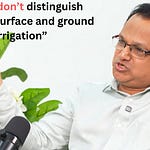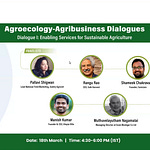It was around September 2024 when I started immersing in the world of Digital Public Goods/ Infrastructure (DPG/DPI). That was the time when phrases like “Population Scale X” began to hover around me.
Now that I have spent a few months dealing with the messy challenges involved in unlocking value curation between smallholding farmers and agritech platforms, I invited Rajeesh Menon and Sriram Bharatam to reorient my vision to look at a bird’s eye view once more and re-energize the possibilities.
As I had expected, working closely on the ground, I had accumulated enough cynicism about the challenges involved in organizing farmers and agritech platforms together.
“When everything becomes fungible then one loses to objective of creating mega companies. if no one can make a monopoly, duopoly, fragmentation just kills the enterprise nature of capitalism. socialism gets hold, and then we keep repeating subsidies and freebie culture” - An agritech entrepreneur while sharing why he was bearish about DPIs in Agriculture.
I had several fundamental questions to navigate and thankfully I could bring all of them to an interesting cohort of experts who closely looked at the process underpinning the value creation journey and the actors who are best suited to drive these value creation journeys.
Rajeesh has spent several years ‘planning, designing and costing’ several DPIs and DPGs across different sectoral contexts and Sriram has had an interesting journey in cross-pollinating learnings from Africa to India and back again to Africa to build a micro-learning platform, thereby incubating one of the largest networks of agricultural entrepreneurs who remain the trusted agents in the last mile, whether in India or Africa.
These are interesting times.
Agriculture, driven by technology, goes through cycles of centralisation and decentralisation. Thanks to India’s faith in Digital Public Infrastructure, the decentralisation wave has reached a critical threshold.
What would it take to critically examine this faith? What would it take to translate this faith into a possibility followed by lived reality? These are the set of questions I set out to answer in this podcast conversation.
While I will leave it to you to judge if I could get answers to those questions, the conversation was deeply enriching and left me with a lot of hope about the possibilities that exist when the networks are ‘carefully curated and coordinated’ to unlock ‘population scale solutions’.
While I hate takeaways, if you are the kind who gets satiated by them, here are a few broad-level nuggets from the conversation:
Digital Public Infrastructure (DPI)
A foundational digital layer that enables:
Identity verification
Trust mechanisms
Widespread access
Decentralized networks
Multi-stakeholder participation
Creating Networks around Youth and Village-Level Entrepreneurs
Focus on creating trusted last-mile agents
Democratizing scientific knowledge
Building platforms that empower local entrepreneurs
Creating economic opportunities in rural areas
Government and Private Sector Collaboration
Importance of collaborative governance models
The government's role in creating guardrails and foundational infrastructure
Private sector driving innovation and transaction layers
Avoiding centralized control while enabling ecosystem growth
Fundamental Meditations on DPI:
DPI is not a one-size-fits-all solution but a flexible framework
Trust is the fundamental currency of digital ecosystems
Patience and long-term vision are crucial for systemic change
Decentralized, locally-adapted solutions are more effective than centralized approaches
Future Vision:
Creating agricultural "pods" or nodes in a larger national grid
Enabling seamless information and transaction flows
Empowering farmers through technology and trusted intermediaries
Do check the complete unfiltered conversation where I navigated my way through several fundamental dilemmas which led to a lot of clarity around the possibilities of digital public infrastructure in smallholding agriculture.
So, what do you think?
How happy are you with today’s edition? I would love to get your candid feedback. Your feedback will be anonymous. Two questions. 1 Minute. Thanks.🙏
💗 If you like “Agribusiness Matters”, please click on Like at the bottom and share it with your friend.











